Rules for arranging an autonomous water supply system for a private house from a well
Your private house is equipped with an independent source of water and you want to organize the water supply of a private house from a well? Agree that having completely independent communications is very convenient. You have no practical experience in arranging a water supply system and you doubt your own strengths?
We will help you cope with the task. After all, a person is able to live without food for more than a month, but without water he will not last three days. Therefore, the organization of uninterrupted supply of water from the well is a priority in your diary.
Useful recommendations on the arrangement of the water supply system collected from our article will come to the aid.
Here you will also find step-by-step instruction with colorful photographs and detailed diagrams. For a simpler perception of information, we selected a video about the independent organization of an autonomous water supply system from a well.
The content of the article:
Water for autonomous water supply
First of all, you need to figure out what water is suitable for an autonomous water supply device.
If you imagine everything simple and accessible, then there are three types of groundwater.
- High end. What managed to seep into the soil, but has not yet become a stable aquifer. The weakest water quality. It’s easy to find out - the level of the hovering varies greatly depending on the season. Not suitable for drinking water.
- Ground water. More stable aquifers. Depth from several meters from the surface to several tens. It is they who are mainly used for autonomous water supply devices.
- Artesian water. The deepest and oldest water carriers. Depth can exceed a hundred meters. Water is most often suitable for drinking purposes, but can be excessively hard, saturated with various minerals.
Water extracted from an autonomous source must undergo a cycle of comprehensive research at the SES or other accredited water analysis organization.
Based on the results of the analyzes made, conclusions are drawn about the possibility of its use as a drinking or technical one.
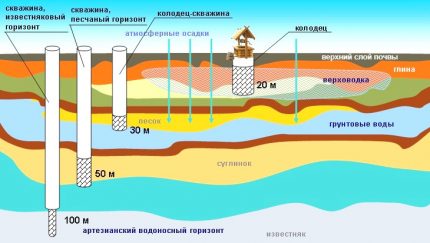
The organization that conducted the water analysis can recommend the optimal treatment scheme if the technical option can acquire a drinking category after filtration.
Types of wells for private water supply
Unsuitable for drinking, the overhead is quite suitable for watering the garden, cleaning and similar needs. It’s easier and cheaper to get it by installing a needle-hole, also called abyssinian well. It is a column of thick-walled pipes VGP Ø from 25 to 40 mm.

The first link of the column is equipped with a tip and a filter arranged directly in the walls of the water-gas pipe. The Abyssinian well is not drilled, but driven into the ground with the help of a weighty woman who is attached to a cable thrown over the block.
This is the cheapest and easiest way to get water for temporary water supply. For summer residents who need only technical water and only in the summer.
Wells on sand can supply water for both technical and drinking purposes. It all depends on the specific hydrogeological situation in the suburban area.
If the water carrier on top overlaps the layer of water-resistant soil, then the water may well be a drinking discharge.
Water-blocking soils that prevent water penetration prevent the penetration of domestic sewage. If the sand containing water does not have natural protection in the form of loam or solid sandy loam, you will most likely have to forget about drinking purposes.
The walls of the well are reinforced with a column of steel casing pipes interconnected by couplings or a weld. Recently, polymer casing is widely used, demanded by private traders because of the affordable price and corrosion resistance.
The design of the well on the sand provides for the installation of a filter to prevent the penetration of gravel and large sand suspension into the wellbore.
Working part downhole filter should extend beyond the aquifer at least 50 cm above and below. its length should be equal to the sum of the thickness of the aquifer and at least 1 m of reserve.
The diameter of the filter should be 50 mm smaller than the diameter of the casing so that it can be freely immersed and removed from the barrel for cleaning or repair.
Wells, the trunk of which is buried in rocky limestone, can do without a filter and partially without casing. These are the deepest water intakes that extract water from cracks in bedrock.
They serve longer than analogues buried in the sand. They do not have a siltation process, asin the thickness of the soils containing water, there is no clay suspension and small grains of sand.

Casing of artesian wells is arranged according to the telescopic principle. Each underlying tier of the structure should be 50 mm narrower than the previous one.
At a depth of more than 100 m, the use of asbestos-cement pipes or drilling a well without casing is permissible, if the rocky walls of the hydraulic structure are not necessary to be strengthened.
If an artesian well has covered more than 10 m of fractured rock containing underground water, then the filter is installed. Its working part is required to cover the entire supplying water thickness.

Subtleties of arranging a water supply system
The process of arranging an automated system water supply from the well straight to the house to meet domestic and household needs can be divided into several stages. We will analyze each of them in more detail.
Stage # 1 - Choosing the Right Place
First of all, you need to determine the location of the well. Once they preferred to drill right under the house - then the kitchens were often arranged in the basement and such a solution seemed convenient.
But the fact is that with such an arrangement it is problematic flush well if necessary. And if it fails, then drilling a new one is completely impossible. So the best place for the well is somewhere outside, although not very far away.
Be sure to take into account sanitary standards. The water intake point should be no closer than 20 meters from the cesspool or septic tank with clay soils: loam, sandy loam.
The presence of sand, capable of letting in and “absorbing” domestic wastewater, increases the indicated distance to 50 meters.
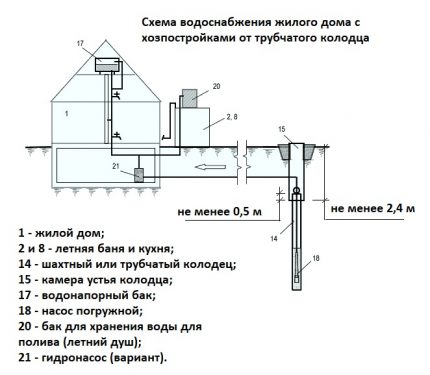
It should be remembered that the farther the water intake point from the water intake point, the more funds will be spent on plumbing device. To summer residents laying a summer water supply on the site, the distance from the source is not too interesting.
Keep it in mind lovers of permanent residence outside the city. Indeed, for the construction of a stationary water supply system, it will be necessary to dig a trench.
Abyssinian well and shallow wells should not be located closer than 5 m to the foundation. Removing underground water, they will at the same time drag particles of loose soil and gradually wash away the rock.
Over time, the process of such weakening can lead to subsidence and deformation of the foundation. But deep wells practically do not affect the properties of the underlying rocks.
Stage # 2 - determination of the general scheme
Structurally, the entire circuit looks simple. The main element is the pump. He raises the water from the depths. May be located directly in the well (submersible type) or work on the surface (surface type pump)The first option provides water intake from a greater depth.

The second is more convenient to mount and maintain, it is preferable for large seasonal breaks (in the summer cottage, for example). But the surface pump does not provide lifting from depths over 8 meters.
Here, one should also take into account the removal along horizontal sections on the surface - 10 meters of water transportation in the horizon are equal to a meter of rise. By the way, another reason not to remove the well strongly from the house.
Next, the water enters accumulator tank. It is a steel or plastic tank. It has a rubber tank where air is pumped.
This compressible volume creates pressure in the system and displaces water to the points of analysis — water, as you know, does not compress, but air has this property.
Automation monitors pressure drops. When the pressure drops below a predetermined level, it turns on the pump; when it reaches, it turns it off. This creates a stable pressure in the system and a normal flow of water to the points of analysis.
The power and volume of the accumulator (and pump) are selected with a small margin, based on the peak flow rate. That is, plus all the points: toilet, sink, shower and so on. If there is seasonal watering, then it is also taken into account in the calculation.
In addition to the pump and drive, the kit includes check valve, preventing the flow of water back into the well, pressure relief valve, various sensors and relays, valves and filters.
Sandy oblique filters are mandatory and prevent sand from entering the system. But fine filters need to be selected based on the composition of the produced water.
All lines of the autonomous water supply network must be shut off by shut-off valves. It is desirable that the connections are made collapsible - with the help of the so-called "American".
But in general, the final configuration of the entire circuit varies, based on specific tasks. But the basis on the basis of the pump and the accumulator always remains unchanged.
Stage # 3 - layout and arrangement of equipment
When installing water from a well with your own hands, it is most often difficult to place equipment. There are many options.
The most rational is to recognize caisson device - a special well at the well, where all the mechanisms are located. It turns out that the equipment is located directly at the point of water intake and the cost of transportation along the horizon is minimal.
The second plus is the silence in the house. The pump station is quite a noisy device, so placing it outside the perimeter of the living area is justified.
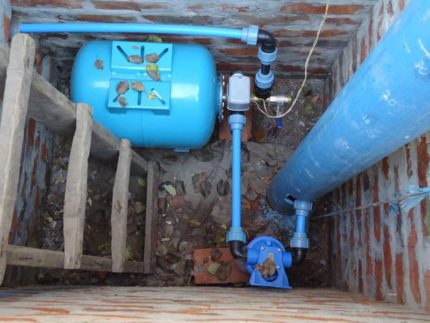
The caisson is a reinforced and insulated pit with a heat-insulated overlap, deepened to a depth below the calculated freezing point.
This eliminates the freezing of the caisson - the fact is that the temperature on the ground at this depth is approximately unchanged all year round and is always above zero.
So with normal insulation of the walls and the tip of the caisson, there is no risk of a drop in temperature. Ground structures in such cases work much worse.

If there is no way to build a caisson, then all the equipment can be placed in the house.
It is good if a separate room is allocated for these purposes.
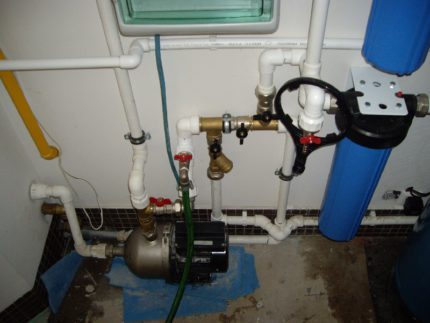
If it is not possible to allocate a separate isolated area for such purposes, you can use the bathroom for this.
But if there is no place there, then you can look at the cabinets under the sink in the kitchen.
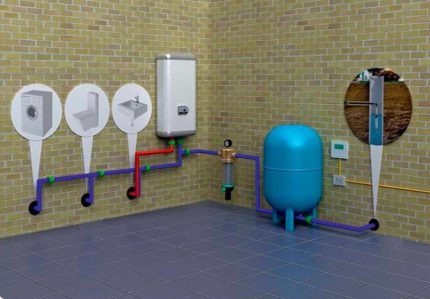
Often placed under a staircase or in a pantry, a basement or even a cellar is well suited for such purposes - this type of equipment is not so bulky and unpretentious.
The main thing here is not the installation site, but its correctness. And the location itself does not affect the quality of work at all. For ease of access - yes. But not for work.
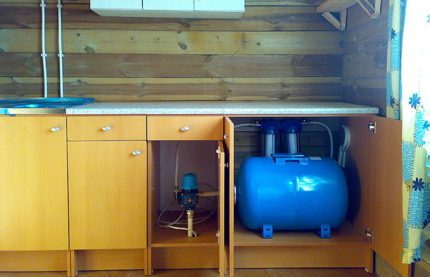
Stage # 4 - pipe laying features
Pipes for mounting the entire system are better to take plastic, HDPE. They are lightweight, durable, reliable. They are not afraid of corrosion; bacterial plaque does not form on the inner surface.
They withstand water shock, can withstand the freezing of water inside them. Although before this, of course, it is better not to bring. They just bend and cut. Laying directly into the ground is allowed.

On the site outside the house, pipes are laid at a depth below the freezing point. In extreme cases, there is a special low-temperature heating cable that is passed into the pipe and connected to the electrical network.
It does not freeze the water inside the highway, even in severe frosts. But this is an extra energy consumption - it is much simpler and more efficient to simply lay the pipe a little deeper.

Entering the water supply from the well into the house is also better done at a depth, underground. If this is impossible and you have to run the pipe into the house through the basement, then this section is subject to mandatory insulation.
Moreover, the insulation should begin even below the freezing level.
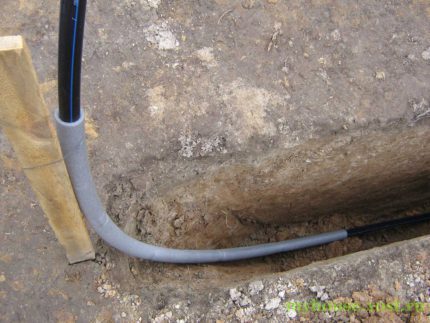
Already in the house, installation can be done in any way: PVC pipes, copper, steel, and so on - to whom it is more convenient and simpler.
The main thing is that it is reliable and soundly.
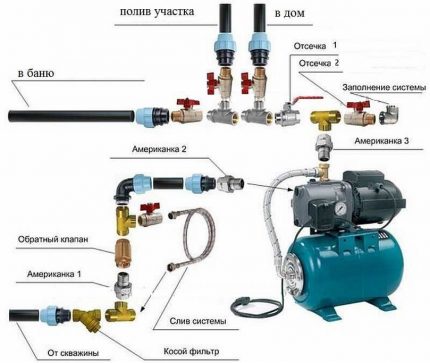
Many questions are caused by the location of the sensors and their assortment, the rules for installing shut-off and safety valves.
Conclusions and useful video on the topic
The best help for explaining such dark places is the video below.
Just remember the principle: always take all the parameters with a margin.
You can build your own water supply system from the well yourself if you follow the instructions of the collections of construction and technological rules.
If you have big doubts about your abilities, then it is better to invite specialists. And although this option will cost more than arranging with your own hands, the result will please you. Moreover, you can save energy and personal time.
Do you have experience in independently arranging a well and laying a water pipe? Or did you encounter certain difficulties in building a water supply system? Please share your experience in the comments to our article.


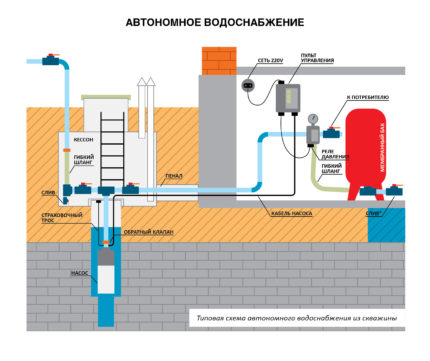

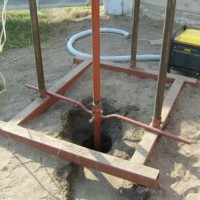 DIY water well: arrangement rules + analysis of 4 popular drilling methods
DIY water well: arrangement rules + analysis of 4 popular drilling methods 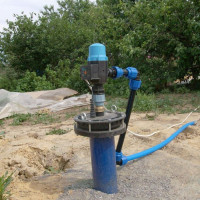 The head for the well: device, types of structures, installation and installation rules
The head for the well: device, types of structures, installation and installation rules  Maintenance of a well for water: rules for the competent operation of a mine
Maintenance of a well for water: rules for the competent operation of a mine 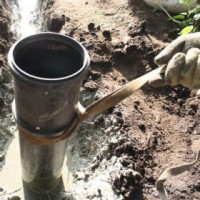 How to pull a casing from a well: rules for dismantling
How to pull a casing from a well: rules for dismantling 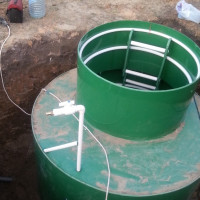 Caisson for a well: what is it, types, purpose, comparative review of structures and installation rules
Caisson for a well: what is it, types, purpose, comparative review of structures and installation rules 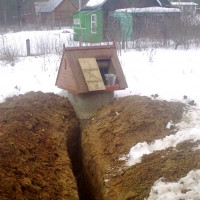 Winter water supply from a well: an overview of the best options and arrangement schemes
Winter water supply from a well: an overview of the best options and arrangement schemes  How much does it cost to connect gas to a private house: the price of organizing gas supply
How much does it cost to connect gas to a private house: the price of organizing gas supply  The best washing machines with dryer: model rating and customer tips
The best washing machines with dryer: model rating and customer tips  What is the color temperature of light and the nuances of choosing the temperature of the lamps to suit your needs
What is the color temperature of light and the nuances of choosing the temperature of the lamps to suit your needs  Replacement of a geyser in an apartment: replacement paperwork + basic norms and requirements
Replacement of a geyser in an apartment: replacement paperwork + basic norms and requirements
I also thought separately from the house to drill a well under water, but the builders dissuaded me. At the same time, the house provided for a large cellar-basement. The well was drilled right there, the necessary equipment was installed in it. And the rest, everything was done according to the description. To operate the baths, just in case, they made a separate well, if anything, it will be a reserve source of water.
The author of the article speaks out against placing the well in the basement of the house, but I think differently. In our house, this is exactly the option and it is convenient.
Before drilling the well, the basement should be deepened (if necessary) so that you can comfortably work and maintain the equipment in the future. We have a well drilled in our basement. The aquifer is located at a depth of 6.5 m. In the well there is a check valve on a plastic pipe, a pump station above the well, the piping from the basement in the house is made of metal-plastic pipes. This option is convenient and requires a minimum of maintenance effort.